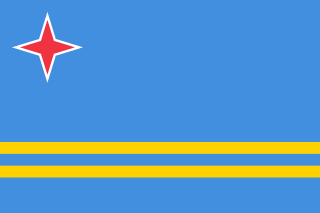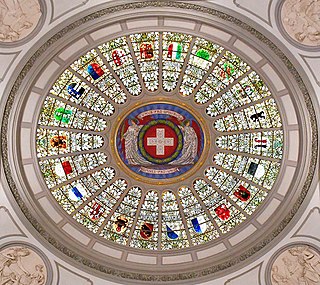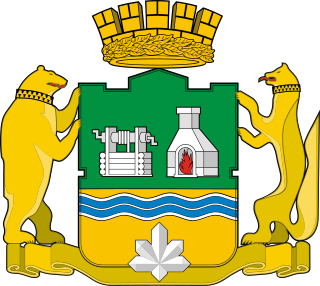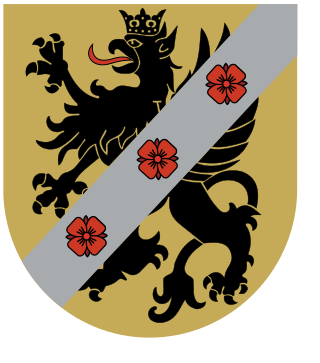
A national flag is a flag that represents and symbolizes a given nation. It is flown by the government of that nation, but can also be flown by its citizens. A national flag is typically designed with specific meanings for its colours and symbols, which may also be used separately from the flag as a symbol of the nation. The design of a national flag is sometimes altered after the occurrence of important historical events. The burning or destruction of a national flag is a greatly symbolic act.

The national flag of Aruba was adopted on 18 March 1976, along with the official anthem "Aruba Dushi Tera". The flag was partially designed by vexillologist Whitney Smith. On 18 March Aruba celebrates National Anthem and Flag Day, marked by local events across the island. It is also a significant day as it represents the Kingdom of the Netherlands giving Aruba an autonomous status.

The flag of Suriname was legally adopted on 25 November 1975, upon the independence of Suriname from the Netherlands.

The National Flag of Canada, often simply referred to as the Canadian flag or, unofficially, as the maple leaf flag or l'Unifolié, consists of a red field with a white square at its centre in the ratio of 1∶2∶1, in which is featured a stylized, red, 11-pointed maple leaf charged in the centre. It is the first flag to have been adopted by both houses of Parliament and officially proclaimed by the Canadian monarch as the country's official national flag. The flag has become the predominant and most recognizable national symbol of Canada.

The provincial flag of Saskatchewan was adopted in 1969. It is blazoned per fess vert and or, in the fly a prairie lily slipped and leaved proper, in the dexter chief an escutcheon of the coat of arms of Saskatchewan fimbriated argent. The symbolism within the flag is shown just with the colours; yellow representing the grain fields in the southern portion of the province where as the green represents the northern forested areas. The western red lily in the fly of the flag is the provincial flower. In 2017, The Minister of Parks, Culture and Sports designated September 22 as Saskatchewan Flag Day.

The coat of arms of Ontario is the armorial emblem representing the Canadian province of Ontario. The arms contain symbols reflecting Ontario's British heritage, along with local symbols. At the upper part of the shield is the red cross of St. George, representing England. The lower portion of the shield features three golden maple leaves on a green background.

The national flag of Ecuador, which consists of horizontal bands of yellow, blue and red, was first adopted by law in 1835 and later on 26 September 1860. The design of the current flag was finalized in 1900 with the addition of the coat of arms in the center of the flag. Before using the yellow, blue and red tricolor, Ecuador's former flag had three light blue stripes and two white stripes with three white stars for each province of the country.The design of the flag is very similar to those of Colombia and Venezuela, which are also former constituent territories of Gran Colombia. All three are based on a proposal by Venezuelan General Francisco de Miranda, which was adopted by Venezuela in 1811 and later Gran Colombia with some modifications. There is a variant of the flag that does not contain the coat of arms that is used by the merchant marine. This flag matches Colombia's in every aspect, but Colombia uses a different design when her merchant marine ships are at sail.

Each of the 26 modern cantons of Switzerland has an official flag and a coat of arms. The history of development of these designs spans the 13th to the 20th centuries.

Regional tartans of Canada are represented by all Canada's provinces and territories having a regional tartan, as do many other regional divisions in Canada. Tartans were first brought to Canada by Scottish settlers; the first province to adopt one officially was Nova Scotia in 1956, and the most recent province was Ontario, in 2000. Except for the tartan of Quebec, all of the provincial and territorial tartans are officially recognized and registered in the books of the Court of the Lord Lyon, King of Arms of Scotland.

The Emblem of Iraq since the rule of Baathism features a golden black eagle looking towards the viewer's left dexter. The eagle is the Eagle of Saladin associated with 20th-century pan-Arabism, bearing a shield of the Iraqi flag, and holding a scroll below with the Arabic words جمهورية العراق.

The coat of arms of Bern, along with the associated flag and heraldic colours, are used both by the Swiss city of Bern and by the canton of the same name. They were also used by the former district of Bern until its abolition in 2009.

The coat of arms of Calgary, Alberta, was adopted in 1902. The arms existed only in black and white until 1984, when an alderman asked the city to develop it in full colour.

The flag of Edmonton in Alberta, Canada features the coat of arms on a white square surmounting a light blue field.

The flag of the Republic of the Rio Grande was used in 1840, during 283 days from January 17 to November 6, as long as the republic existed. This country was formed by the northeastern Mexican states of Coahuila, Nuevo León, and Tamaulipas. The flag was no longer used following the defeat of the Republic of the Rio Grande by Mexican troops.

The flag of Austin is the official municipal flag of Austin, Texas. The flag simply consists of a white field with the seal of Austin without the surrounding circle of text. Below the seal of Austin is the text "CITY OF AUSTIN", written in blue and arched upwards.

The coat of arms of Yekaterinburg is the official municipal coat of arms of Yekaterinburg, Russia. The current symbol was adopted on 23 May 2008 and consists of a French shield divided horizontally into two fields, with a white mine shaft and a white furnace within the top field, which is green, and a blue wavy bend within the bottom field, which is gold. A gold bear and gold sable are located to the left and right of the shield, respectively. A gold crown with a gold laurel wreath is located above the shield and a gold ribbon is located below the shield. A grey druse is located at the bottom center of the shield.

The civil flag of the Lubusz Voivodeship, Poland is a rectangle divided into 4 stripes, which are, from top to bottom, yellow (golden), white, (silver), red, and green. Top and bottom stripes are twice the size of the 2 middle stripes. The state flag features the design of the civil flag, with the coat of arms of the voivodeship placed in the centre. It was adopted on 26 June 2000.

The coat of arms of Sandomierz County is divided vertically into two fields, with the left field consisting of six horizontal stripes, alternating between red and white (silver) colours, and the right field featuring nine yellow (golden) six-armed stars, placed in three horizontal rows. The flag of the county divided into three vertical stripes, of blue, yellow, and blue colour, with the middle stripe being three times, and the coat of arms placed in the centre. The design was based on the historical coat of arms of the Sandomierz Voivodeship, used from 14th to 18th centuries.

The coat of arms of Wejherowo County, Pomeranian Voivodeship, located in north-central Poland, consists of a black griffin with a black crown on its head, and a grey (silver) band (stripe) running from the top right to the bottom left corner of the shield, with three red roses on it. The design is placed within a light orange (golden) escutcheon (shield). The flag of the county is divided vertically into two stripes of identical width; black on the left, and light orange on the right. In the centre of the left field is placed the coat of arms. Both symbols were established in 2000.




















